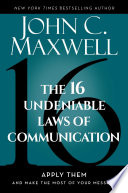

Clarity is the cornerstone of effective communication. When a message is clear, it minimizes misunderstandings and enhances the likelihood of the desired response. This law emphasizes the importance of simplicity and directness in communication. To achieve clarity, one must avoid jargon, complex language, and convoluted explanations. Instead, the communicator should focus on structuring their message logically and using relatable examples. By ensuring that the audience comprehends the message without ambiguity, the communicator can foster trust and engagement. Clarity also involves being concise; it is essential to convey the message in as few words as possible without sacrificing meaning. This law not only applies to verbal communication but also to written forms, where clarity can make or break the effectiveness of a document, email, or presentation.
Continue readingConnection refers to the emotional bond between the communicator and the audience. It is vital for establishing rapport and fostering a receptive atmosphere for the message. This law highlights the importance of empathy, understanding the audience's perspective, and relating to their experiences. To connect effectively, communicators should share personal stories, demonstrate vulnerability, and actively listen to feedback. By doing so, they create a sense of belonging and trust, which encourages open dialogue. Connection can also be achieved through body language, tone of voice, and eye contact. When the audience feels a connection, they are more likely to engage with the message and respond positively.
Continue readingTiming is crucial in communication, as delivering a message at the right moment can significantly impact its reception. This law stresses the importance of being aware of external factors, such as the audience's mood or current events, that may influence how a message is perceived. Effective communicators must be attuned to these dynamics and adapt their timing accordingly. For instance, introducing a new idea during a moment of crisis may not yield the desired reaction, while doing so during a period of optimism may lead to enthusiastic acceptance. Additionally, pacing is essential; communicators should allow for pauses and moments of reflection to let information sink in. By mastering the art of timing, communicators can enhance the effectiveness of their messages.
Continue readingAuthenticity is about being genuine and true to oneself in communication. This law emphasizes that audiences can easily detect insincerity, which can undermine trust and credibility. To communicate authentically, individuals must align their words with their values and beliefs. This involves being honest, transparent, and vulnerable when appropriate. Authentic communication fosters trust and encourages the audience to engage with the message on a deeper level. It also allows for a more personal connection, as audiences are drawn to communicators who are relatable and real. By embracing authenticity, communicators can create a powerful and lasting impact.
Continue readingStorytelling is a powerful tool in communication that can captivate and inspire audiences. This law highlights the effectiveness of narratives in conveying messages and making complex ideas more relatable. Stories engage emotions, making them memorable and impactful. Effective communicators harness the power of storytelling by structuring their messages around a central narrative that resonates with the audience. This involves creating characters, setting, conflict, and resolution, allowing the audience to connect with the message on a personal level. By weaving stories into their communication, individuals can enhance understanding and retention while fostering a sense of connection.
Continue readingFeedback is an essential component of effective communication, as it allows for two-way interaction and ensures that messages are understood as intended. This law emphasizes the importance of soliciting and embracing feedback from the audience. By encouraging questions, comments, and discussions, communicators can gauge the effectiveness of their messages and make necessary adjustments. Feedback also promotes engagement and shows the audience that their opinions are valued. Moreover, it fosters a culture of open communication where individuals feel comfortable expressing their thoughts. By actively seeking and responding to feedback, communicators can enhance their skills and improve future interactions.
Continue readingAdaptability is the ability to adjust one's communication style to suit different audiences and contexts. This law stresses that effective communicators must be flexible and responsive to the needs of their audience. This involves being aware of cultural differences, varying levels of knowledge, and individual preferences. By tailoring messages to fit the audience's background and expectations, communicators can enhance engagement and understanding. Adaptability also means being willing to change tactics mid-conversation if the audience's reactions suggest a different approach is needed. This responsiveness not only improves communication effectiveness but also demonstrates respect for the audience's perspective.
Continue reading